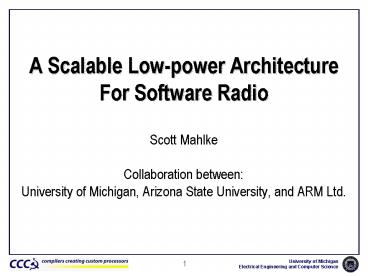A Scalable Lowpower Architecture For Software Radio PowerPoint PPT Presentation
Title: A Scalable Lowpower Architecture For Software Radio
1
A Scalable Low-power Architecture For Software
Radio
- Scott Mahlke
- Collaboration between
- University of Michigan, Arizona State University,
and ARM Ltd.
2
Anatomy of a Cellular Phone
3
Software Defined Radio (SDR)
- Use software routines instead of ASICs for the
physical layer operations of wireless
communication system
ASICs (PHY)
Software Routines
Programmable Hardware
- Rest of the talk
- Characteristics of SDR algorithms
- SODA architecture for power-efficient SDR
- Compilation challenges and approach
4
Advantages of SDR
- Lower costs
- Platform longevity, higher volume
- SW has lower development costs
- Time to market
- Future protocols will have complex
implementations - Overlap testing/development cycles
- Adaptability
- Standards change over time
- Multi-mode operation
- Sharing hardware resources
5
Why is SDR Challenging?
6
The Anatomy of Wireless Protocols
1. Filtering suppress signals outside frequency
band
2. Modulation map source information onto signal
waveforms
3. Channel Estimation Estimate channel condition
for transceivers
4. Error Correction correct errors induced by
noisy channel
7
W-CDMA Workload Profile
- One operation is equivalent to one RISC
instruction
- Searcher, Turbo decoder, and LPF are dominant
workloads
- Workload profile varies according to operation
state
8
SDR Kernel Characteristics
- 8 to 16-bit precision
- Vector operations
- long vectors
- constant vector size
- Static data movement patterns
- Scalar operations
9
SODA System Architecture for 3G
- 4 PEs
- static kernel mapping and scheduling
- SIMDScalar units
- 1 ARM GPP controller
- scalar algorithms and protocol controls
10
SODA System Architecture for 3G
- 2-Level scratchpad memories
- 12KB Local scratchpad memory for stream queues
- 64KB global scratchpad memory for large buffers
- Low-throughput shared bus
- 200MHz 32-bit bus
- inter-PE communication using DMA
11
SODA PE Architecture
12
SODA PE SIMD Pipeline
13
SODA PE SIMD Pipeline
14
SODA PE SIMD Shuffle Network
- Shuffle exchange
- Inverse shuffle exchange
- Exchange only
- Iterative feedback
15
SODA PE Scalar Pipeline
16
Power Consumption at 180nm
- 180nm ? 3 W, 26.6 mm2
- 90nm (est) ? 0.5 W, 6.7 mm2
17
SDR Compilation Strategy
- Two level application description
- System-level Concurrent tasks extracted from C
channels attributes - Kernel-level Data parallelism extracted from C
vectors Matlab operators - System compilation Task level parallelism
- Generates tasks, schedules, communication stubs,
DMA requests, timing assertions, synchronization,
debug support - Kernel compilation Data level parallelism
- Lower virtual DLP to physical implementation
18
Stylized Automatic Parallelization
void main() for(int i0 iltN i)
int x spread(wi) int y
scramb(x) fir(y)
19
Kernel Level Compilation
templateltclass T, TAPS, BSIZEgt kernel FIR
vectorltT, TAPSgt z vectorltT, TAPSgt coeff
void set_coeff(vectorltT, TAPSgt c) coeff c
void run(channelltT, BSIZEgt inbuf,
channelltT, BSIZEgt outbuf) T in, out
for (i 0 i lt BSIZE i) in
inbuf.pop() z coeff in out
z0 outbuf.push(out) z
(z(1TAPS-1),0)
20
Final Thoughts
- 2G and 3G SDR solutions are achievable in 90nm
- 3.9G ? 4-10x more performance with mW power
consumption - Core technologies for future networks
- OFDM ? 64 2048 point FFT
- MIMO use of multiple antennas for
transmission/reception - Low density parity check codes
- Key insight SDR requires innovation across
algorithm, software and hardware - SDR platforms offer low-cost, longevity, and
adaptability

